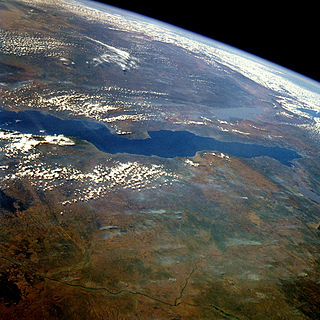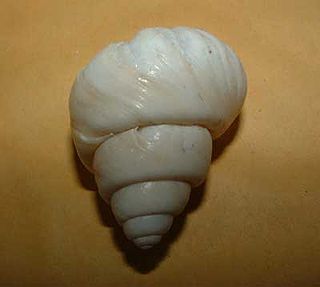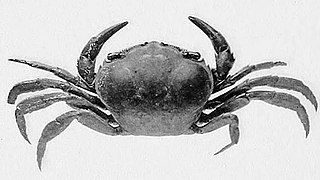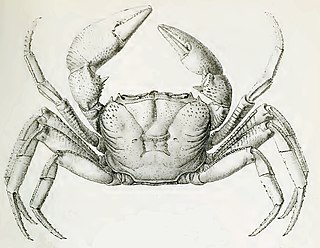
Lake Tanganyika is an African Great Lake. It is the second-largest freshwater lake by volume and the second deepest, in both cases after Lake Baikal in Siberia. It is the world's longest freshwater lake. The lake is shared among four countries—Tanzania, the Democratic Republic of the Congo, Burundi, and Zambia—with Tanzania (46%) and the DRC (40%) possessing the majority of the lake. It drains into the Congo River system and ultimately into the Atlantic Ocean.

Neothauma is a genus of freshwater snail with a gill and an operculum, an aquatic gastropod mollusc in the subfamily Bellamyinae of the family Viviparidae.

Ceylonthelphusa is a genus of freshwater crabs endemic to Sri Lanka, where they live in moist lowland forests, swamps and rivers. Many of the species are on the IUCN Red List of threatened species, with the greatest risk factor being habitat loss. Ceylonthelphusa contains these species:
Mahatha is a genus of freshwater crabs endemic to Sri Lanka. Four of the six species are critically endangered due to habitat loss, and two are listed as Least Concern on the IUCN Red List.

Oziotelphusa is a genus of freshwater crabs in the family Gecarcinucidae. Its members are found in Sri Lanka and southern India. The genus was formerly placed within family Parathelphusidae, but now it is accepted that Parathelphusidae is the junior synonym of Gecarcinucidae.
Perbrinckia is a genus of freshwater crabs of the family Gecarcinucidae that is endemic to Sri Lanka, named after Per Brinck. Its natural habitats are subtropical or tropical moist lowland forests, subtropical or tropical swamps, and rivers. It contains 14 species, most of which are included on the IUCN Red List as critically endangered species (CR) or vulnerable species (VU) because they are threatened by habitat loss; only one species is of least concern (LC).
Rotundopotamonautes aloysiisabaudiae is a species of crab in the family Potamonautidae. It is found in the Democratic Republic of the Congo, Sudan, and Uganda. Its natural habitat is rivers.
Potamonautes gerdalensis is a species of crab in the family Potamonautidae. It is found in the Democratic Republic of the Congo, Kenya, Tanzania, and Uganda. Its natural habitats are rivers and freshwater lakes. It is threatened by habitat loss.
Potamonautes infravallatus is a species of crustacean in the family Potamonautidae. It is endemic to Tanzania. Its natural habitat is rivers.
Potamonautes mutandensis is an endangered species of freshwater crab in the family Potamonautidae. It is found in Lake Mutanda and Lake Kivu in Uganda, Rwanda and DR Congo.
Potamonautes platycentron is a species of freshwater crab in the family Potamonautidae, which is endemic to Lake Chala in Kenya and Tanzania. It was originally described by Franz Martin Hilgendorf in 1897, as Telphusa platycentron.

Potamonautes platynotus is a species of freshwater crab which is endemic to Lake Tanganyika, where it is the only freshwater crab outside the genus Platythelphusa. Although primarily aquatic, P. platynotus is sometimes seen out of water, and can survive for many hours without water.
Potamonautes raybouldi is a species of freshwater crab. It lives in water-filled tree holes in forests in the eastern Usambara Mountains of Tanzania and the Shimba Hills in Kenya. It is threatened by deforestation resulting from the expansion of the human population, and is listed as a vulnerable species on the IUCN Red List. The species was described in 2004, and named after Professor John N. Raybould of the University of Bristol, who collected the first specimens of the species.
Rotundopotamonautes rukwanzi is a species of crab in the family Potamonautidae. It is endemic to Uganda. Its natural habitat is freshwater lakes.
Spiralothelphusa is a genus of freshwater crabs in the family Gecarcinucidae. It contains these species, all of which are included on the IUCN Red List:

Deckenia is a genus of freshwater crabs from East Africa, in the family Potamonautidae, or sometimes in a family of its own, Deckeniidae. The genus was named by Hilgendorf after Karl Klaus von der Decken who collected the first examples during his expeditions to Africa. Both species live in swamps from Eyl in Somalia to Dar es Salaam, Tanzania, both in coastal areas and further inland. A third species, Deckenia alluaudi, lives in the Seychelles, and has been transferred to a separate genus, Seychellum.

Potamonautes sidneyi is a species of freshwater crab in the family Potamonautidae. The common name is the Natal river crab or Sidney's river crab, although they may also be referred to as "river crabs", "fresh water crabs" or "land crabs".

Around 1,300 species of freshwater crabs are distributed throughout the tropics and subtropics, divided among eight families. They show direct development and maternal care of a small number of offspring, in contrast to marine crabs, which release thousands of planktonic larvae. This limits the dispersal abilities of freshwater crabs, so they tend to be endemic to small areas. As a result, a large proportion are threatened with extinction.

Seychellum alluaudi is a species of freshwater crab endemic to the Seychelles, and the only true freshwater crab in that country. It lives in rainforest streams on the archipelago's granitic high islands. Although it may be abundant, little is known about its biology. If its habitat were to decline in quality, S. alluaudi might become endangered, but it is currently listed as Vulnerable on the IUCN Red List.
Migmathelphusa olivacea is a species of freshwater crab found in Lake Poso on the Indonesian island of Sulawesi. It is the only species in its genus. It is listed by the IUCN as Endangered, given "its extent of occurrence and area of occupancy is less than 500 square kilometres (190 sq mi)", and its individuals being found in less than five locations. There is also a "decline in the extent and quality of its habitat and it is not found in a protected area". Being found around a lake, "present and future threats to this species include human-induced habitat loss/degradation due to population increases and industrial and agrarian development".










